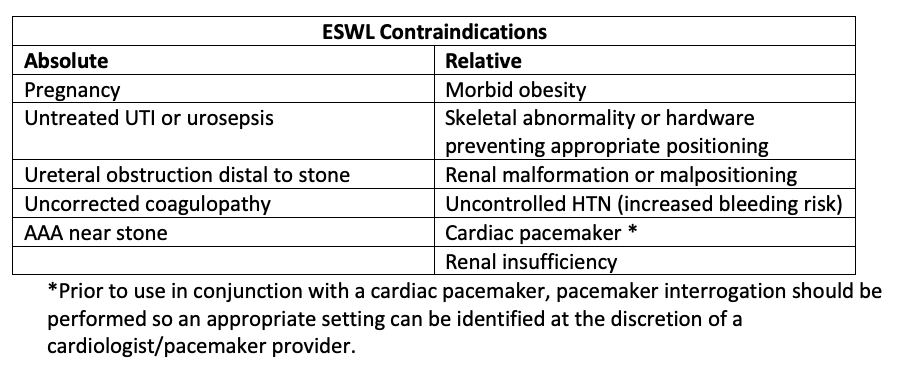Copy link
Lithotripsy: Contraindications
Last updated: 05/28/2019
Extracorporeal shockwave lithotripsy (ESWL) is a procedure that involves targeting renal or ureteral stones with electromagnetic shocks that work to break up the stones into smaller fragments. Ideally, these smaller fragments can then be excreted via urine without additional instrumentation or interventional support. Prior to performing the procedure, both the anesthesiologist and urologist should be familiar with the contraindications to ESWL.
The relative and absolute contraindications to this therapy are listed in the table below.
Pregnancy: Lithotripsy has been associated with low birth weight, placental displacement, and miscarriage. Women of childbearing age should have a pregnancy test, documented to be negative prior to treatment.
Untreated coagulopathy: An untreated bleeding disorder or use of antiplatelet or other anticoagulant medications, particularly when the kidney is included in the blast-path of treatment (meaning renal and upper ureteral stones) are a contraindication to treatment. There are several case reports which demonstrate bleeding complications in the above patient population.
Although caution should be exercised with these patients, pacemakers, automatic implantable cardioverter-defibrillators (AICDs), abdominal aortic aneurysms, orthopedic prosthesis, or obesity are no longer considered contraindications to lithotripsy treatment.
Cardiac Implantable Electronic Device (CIED): Initially, the presence of a CIED was believed to preclude patients from receiving lithotripsy, given the theoretical concern that the shockwaves could damage the CIED. However, technology has improved, meaning current lithotripsy requires less energy transferred to the patient. Older guidelines recommended a treatment distance of 15 cm from the device to the treatment area, meaning abdominal CIEDs are contraindicated but newer research suggests that CIEDs do not have complications from lithotripsy treatment. If the patient has a pacemaker, programmability should be established prior to treatment and device should be switched to a nondemand mode in case the shock waves interfere with pacemaker function. Most pacemakers located pectorally are at a safe distance from the blast. If an AICD is present, it should be shut off immediately prior to treatment with an alternate means of defibrillation available and reactivated after the procedure.

ESWL Contraindications table
References
- Reynolds, L. F., Kroczak, T., & Pace, K. T. (2018). Indication and contraindications for shock wave lithotripsy and how to improve outcomes. Asian Journal of Urology , 256-263. PubMed Link
Copyright Information

This work is licensed under a Creative Commons Attribution-NonCommercial-NoDerivatives 4.0 International License.